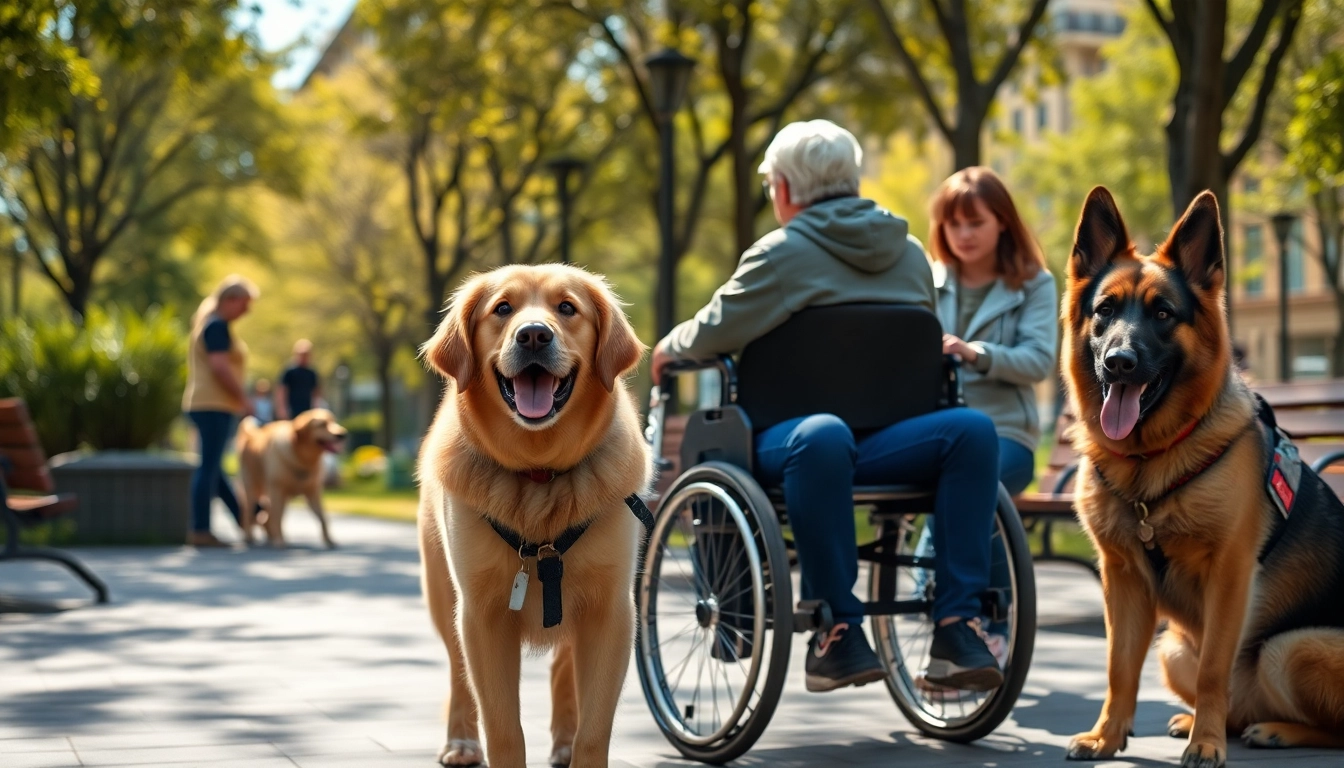
What Are Service Dogs?
Definition and Purpose of Service Dogs
Service dogs are highly trained canines that perform specific tasks to assist individuals with disabilities. The Americans with Disabilities Act (ADA) defines a service dog as a dog that is individually trained to do work or perform tasks for the benefit of a person with a disability. These tasks might include guiding individuals who are blind, alerting those who are deaf, pulling a wheelchair, alerting and protecting a person who is having a seizure, reminding a person with mental illness to take prescribed medications, calming a person with post-traumatic stress disorder (PTSD) during an anxiety attack, or performing other special tasks. The purpose of service dogs is not only to provide physical assistance but also to enhance the quality of life for individuals with disabilities, thereby fostering independence and a sense of normalcy.
Common Breeds Used as Service Dogs
While any breed can technically be trained as a service dog, certain breeds tend to be more common due to their characteristics, temperament, and trainability. The most frequently used breeds include:
- Labrador Retrievers: Known for their friendly disposition, intelligence, and ability to learn commands quickly.
- Golden Retrievers: Similar to Labradors, they are gentle, eager to please, and highly trainable.
- German Shepherds: Often utilized in police and military work, they are intelligent and versatile, making them excellent service dogs.
- Bernese Mountain Dogs: Valued for their calm nature and ability to provide emotional support.
- Boxers: Their playful and energetic demeanor helps in offering support while encouraging physical activity for their owners.
Other breeds, including Doberman Pinschers and Poodles, are also popular, especially since Poodles come in various sizes, making them suitable for various tasks.
Legal Definitions and Protections
The legal protections for service dogs under the ADA are significant, allowing individuals to take their service dogs into public places where pets are not permitted. The ADA stipulates that service dogs must be trained to perform specific tasks related to the individual’s disability. Importantly, emotional support animals and therapy dogs do not fall under these definitions and do not qualify for the same legal protections. It is crucial for businesses and service providers to understand these distinctions to avoid discrimination against individuals who rely on service dogs.
How Service Dogs Assist Individuals
Physical Assistance and Mobility Support
One of the primary functions of service dogs includes providing physical assistance and mobility support. Many individuals with physical disabilities find it challenging to perform daily tasks without assistance. Service dogs can help by:
- Retrieving items that the owner may drop or cannot reach.
- Helping individuals navigate obstacles, such as guiding them around crowds or through doorways.
- Providing balance while walking, reducing the risk of falls for those with mobility issues.
- Carrying items in a specially designed backpack, making daily errands easier.
In addition to aiding with physical tasks, service dogs can also provide emotional security, helping their owners navigate challenging environments, such as busy shopping malls or large events.
Psychological Benefits of Service Dogs
Beyond physical tasks, the psychological benefits of having a service dog can be profound. Many individuals experience increased emotional stability, decreased anxiety, and enhanced overall well-being due to the companionship of their service dogs. The presence of a service dog can:
- Reduce feelings of isolation or depression.
- Provide a sense of purpose and responsibility, which can be particularly beneficial for individuals with PTSD or severe anxiety disorders.
- Encourage social interactions since service dogs often attract attention and can serve as conversation starters.
Numerous studies have shown that interaction with dogs can lead to increased levels of oxytocin, a hormone associated with bonding and stress relief, thus highlighting the importance of the human-animal bond.
Specific Tasks Performed by Service Dogs
Service dogs are trained to perform specific, individualized tasks that align with their owner’s unique needs. Some common tasks include:
- Guide Dogs: These dogs assist individuals who are visually impaired by navigating obstacles and ensuring their safety.
- Seizure Alert Dogs: These dogs are trained to sense an impending seizure and can alert their owners or even seek help.
- Medical Alert Dogs: They can sense fluctuations in medical conditions, such as blood sugar levels for diabetics, enabling timely intervention.
- Mobility Assistance Dogs: These dogs can retrieve dropped items and provide stability for individuals with mobility challenges.
- Psychiatric Service Dogs: They can assist individuals with mental health disorders by offering reminders for medication and providing comforting pressure during anxiety or panic attacks.
Each service dog is tailored to the specific needs of its owner, which requires extensive training and bonding between the dog and its handler.
Training Service Dogs: A Comprehensive Guide
Overview of Training Methods
Training a service dog requires an experienced trainer who employs positive reinforcement techniques. The training process generally involves:
- Basic Obedience Training: Before learning specific tasks, the dog must master essential commands like sit, stay, come, and heel.
- Task-Specific Training: Each service dog is trained for tasks that directly relate to their handler’s disability, which may take months to years, depending on the complexity of the tasks.
- Generalization: Service dogs must learn to perform tasks in various environments, ensuring they can handle distractions while still providing support.
- Public Access Training: This training prepares the dog to behave appropriately in public settings, which is crucial for the handler’s safety and comfort.
Ongoing training is equally essential, as both the dog and owner must reinforce commands and skills to adapt to changing needs.
Organizations That Train Service Dogs
Numerous organizations train service dogs, often providing support and resources for individuals needing assistance. These organizations typically focus on specific types of service dogs, such as:
- Mobility Assistance Dogs: These organizations focus on training dogs to assist individuals with physical disabilities.
- Guide Dogs: Specializing in training dogs for individuals who are blind or visually impaired, these programs emphasize navigation skills.
- Psychiatric Service Dogs: Organizations that focus on training dogs to help manage mental health conditions.
Before choosing an organization, it’s essential for prospective dog owners to research and ensure that the organization has a reputable training program and follow ethical standards in training and placement.
Requirements for Service Dog Training
Not all dogs are cut out to be service dogs. When selecting a dog, certain characteristics should be assessed:
- Temperament: The ideal service dog should be calm, reliable, and friendly.
- Age: Younger dogs may be more adaptable during training, although older dogs can also be trained effectively.
- Health: A service dog must be in good health and physically able to perform the required tasks.
Owners and trainers alike must be committed to a rigorous training process, ensuring alignment with the specific needs of the handler.
FAQs About Service Dogs
What Disabilities Qualify for a Service Dog?
Service dogs assist people with a wide range of disabilities. Common qualifications include:
- Visual impairments
- Hearing impairments
- Mobility limitations
- Seizure disorders
- Mental health conditions, including PTSD
Ultimately, if a disability significantly impacts an individual’s daily life, training a service dog to assist is possible.
Service Dogs vs. Emotional Support Animals
It’s essential to distinguish between service dogs and emotional support animals (ESAs). Service dogs are extensively trained to perform specific tasks for those with disabilities, whereas ESAs provide comfort but are not trained for specific tasks. As a result, ESAs do not hold the same public access rights under the ADA as service dogs do.
Myths and Misconceptions About Service Dogs
Several misconceptions exist surrounding service dogs that can lead to confusion. Some common myths include:
- All dogs can be service dogs – Only specific breeds and individual dogs trained for specific tasks can be service dogs.
- Service dogs are just pets – Service dogs are trained companions with responsibilities far exceeding those of a pet.
- You can pet a service dog if you ask – Individuals should avoid approaching or petting a service dog without permission, as their focus is on supporting their handler.
Understanding and addressing these myths is crucial for promoting the rights and needs of service dog handlers.
How to Obtain a Service Dog
Steps to Apply for a Service Dog
Acquiring a service dog involves several steps:
- Identify Needs: Understand the specific assistance needed and how a service dog can help.
- Research Organizations: Look into reputable organizations that train and provide service dogs.
- Complete an Application: Most organizations require an application that highlights the individual’s disability and how a service dog will assist.
- Attend Interviews: Some organizations may conduct interviews to match the right dog with the handler’s needs.
Individual requirements and processes vary by organization, so thorough research is crucial.
Cost Considerations and Funding Options
Funding a service dog can be a significant concern. Training service dogs can cost thousands of dollars. Many organizations do not charge a fee for their dogs or offer a sliding scale based on the handler’s financial situation. Additionally, various grants and financial assistance programs may be available for individuals seeking to obtain a service dog. It’s essential to explore these options to alleviate financial burdens.
Post-Adoption Support and Resources
After obtaining a service dog, ongoing support is crucial for both the handler and the dog. Training should continue to reinforce skills, and routine veterinary care is essential for the dog’s health. Many organizations provide post-adoption support resources, including training refreshers, community support groups, and informational workshops. Staying connected with these resources enhances the service dog’s effectiveness and deepens the bond between the handler and their dog.








